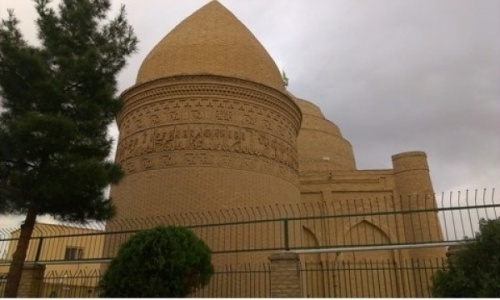Borj-e Čehel Doḵtar, also known as Čehel Doḵtarān, is a brick Saljūq tower built in Dāmghān, one of the main cities of Ghūmes in 1054.
This brick cylindrical tower of Čehel Doḵtar is located in Dāmghān, one of Iran's central cities. As the main city of Ghūmes, Dāmghān had flourished during the Buyid, the Ziyarid and the Saljūq dynasties (Ibn Faqih Hamedani, p.167; Yaqubi, p. 52; Hakim, p. 862; E’temad al-Saltana, v. 3, p.256; Abu al-Fada, p.498; Hamawi, v.4, p.203; Haqiqat, pp.13-25). Čehel Doḵtar was originally outside the hisār or city wall of Dāmghān and was probably situated in an old cemetery. It was developed some time later because of its location on the road from Tehran to Mashhad and is now located in the center of modern Dāmghān (Anisi, p.309; Blair, p.123). Towers were usually constructed near religious buildings such as mosques and shrines revered by Muslims. So the Čehel Doḵtar lies at the rear courtyard of the shrines of Imamzāda Jafar and Mohammad, two Shiite figures.
Based on the Kūfic inscription above the single entrance, the tower was constructed under the patronage of a Daylami commander named Amir Abu Shujā Asfar Ibn Kurdwayha in 1054 (Khanikov, p.87). This site is a 14.8 m. high tower with an interior diameter of 5.5 m. and an exterior diameter of 7.80 m. and a conical roof. It is probable that Čehel Doḵtar tower in Dāmghān, like the one in Semnān, was originally constructed primarily of adobe and was reconstructed in the 11th century with the current brick and semi-conical roof (Haqiqat, p.315). The primary entrance to the tower is 1/87 to 2/55 meters with a crescent arch. Its inner wall is covered with plaster and paved with brick. Today there is a tomb on the site which does not fit into the tower structure. It seems evident that this was established and placed here later.
The tower of Čehel Doḵtar then, was adorned with brickwork only to showcase their delicate simplicity and nakedness. The decoration above the exterior flanges is also composed of three decorative bands but in this case there is also an inscription. The bands encircle the tomb below the corbelled cornice (Anisi, p.146). The scripts used for the inscriptions on the Čehel Doḵtar are delicately elongated and the knots are frequent so that the brick decoration of the upper zone forms a complete match to the bodies of the letters in the lower one (Blair, p.125). Čehel Doḵtar is meant to be an example of Saljūq towers whose brick structure evokes naked feminine bodies lying under the sunlight.
Seljuq towers had astronomical, military, and travel guide functions as well as symbols of political power. They were constructed at specific spots to help people learn more about the time of day and even the seasons. Regardless of the many functions attributed to the towers, they were primarily intended as monumental tombs for significant people. On the basis of its inscription, Čehel Doḵtar Tower also seems to be the family tomb of Amir Abu Shuja Asfar ibn Kurdwayha, a notable Daylami commander. The Kūfic inscription of the tower is “بسمله امر ببناء هذه القبه الامیر الجلیل ابوشجاع اسفار بگی پیر اصفهان رضی الله عنه و ا{غفر} ذنوبه مستعدا لنومه تربه له ولا ولاده غفر الله لهم و الفه بنبینا محمد صلی الله علیه فی سنت ست و اربعین و اربعمائه.» and also «بسم الله الامیر الجلیل ابوشجاع اسفاربگی پیر اصفهان الملک لله».
Its translation is “Basmala. The exalted Amir Abu Shuja Afsar Begi, Pir of Isfahan, may God be pleased with him and forgive his sins, ordered the construction of this cupola, preparing for his sleep a tomb for himself and his sons, may God forgive them and join him to our Prophet Muhammad, may God bless Him, in the year four hundred forty-six {12 April 1054- 1 April 1055}”.and also “In the name of God. The exalted Amir Abu Shuja Asar Begi Pir of Isfahan. Dominion belongs to God” (Shayestefar, p.67).
Even though towers are now considered Islamic architecture monuments, their origins lie in Iran's Pre-Islamic era. Importantly, regarding the Čehel Doḵtar Tower, Bastani Parizi in Ḵatūneh Haftqal’eh examines the origins of the word dukhtar in many monuments. These include towers, castles, minarets, bridges, shrines and temples (Bastani Parizi, p.250). He takes readers to all parts of Iran in medieval times from Transoxiana to Greece in the Mediterranean area (Bastani Parizi, p.166). Bringing such numerous examples of the word doḵtarn on social buildings to the fore impresses readers in such a way that Čehel Doḵtar tower in Dāmghān becomes but a single example among myriad historical buildings named doḵtarn, its derivations, and equivalents (Bastani Parizi, pp.152-154; pp.172-178; pp.181-182; pp.205-282; pp.243-251; pp.251-259; pp.263-264; pp.283-293). Regarding their common features, Bastani proposes a plausible hypothesis that the word doḵtarn and its derivations or equivalents refer to Anahita, the Iranian pre-Islamic goddess and to all feminine aspects of the ancient Iranian religion before Zoroaster (Bastani Parizi, pp.194-196).
Isma’il ibn Ali Abu al-Fada, Taqvim al-Boldān, Tehran: Bonyād-e Farhang-e Iran, 1966.
Maryam Kamali
References
Anisi, Alireza, Early Islamic Architecture in Iran, 637-1059, Ph.D. thesis, University of Edinburgh, 2007.
Bastani Parizi, Mohammad Ebrahim, Ḵatūn-e Haftqal’eh Majmueh Maqālāt-e Tariḵi, Tehran: Ruzbahan, 1989,
Blair, Shiela, The Monumental Inscriptions from Early Islamic Iran and Transoxiana, Leiden; New York: E.J. Brill, 1992.
E’temad al-Saltana, Mohammad Hasan, Matla’ al-Shams, ed. Teimur Borhan Limudehi, Tehran: Farhangsara, 1983.
Hakim, Mohammad Khan, Ganj-e Dānesh, Tehran: Zarrin, 1975.
Hamawi, Yaqut ibn Abdollah, Mo’jam al-Boldān, v. 4, Tehran: Sa’di, 1965.
Haqiqat, Abdul Rafi’, Tariḵ-i Ghūmes, Tehran: Kumes, 2001.
Hamedani, Ahmad ibn Mohammad ibn Faqih, Moḵtasar al-Boldān, tr. H. Masoud, Tehran, Bonyād-e Farhang-e Iran, 1970.
Khanikov, Nikolai Vladimirovich, Safarnāma-ye Khanikov, tr. Into Persian. Aqdas Yaqmaie & Abol Qasim Bigonah, Mashhad: Astan-e Qods, 1996.
Shayestefar, Mahnaz “Maqbarey-ye Čehel Doḵtar-e Dāmqān”, Honarha-ye Tajassomi, 2002, 16, pp. 64-68.
Yaqubi, Ahmad ibn Eshaq, Al-Boldan, tr. Ebrahim Ayati, Tehran, Tarjuma wa Nashr-i Ketab, 1968.

